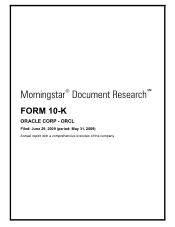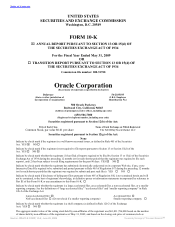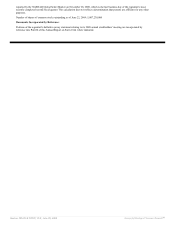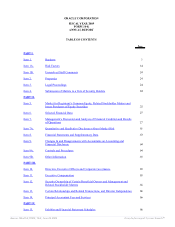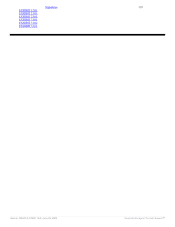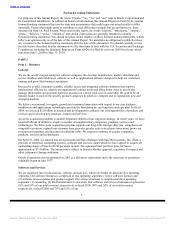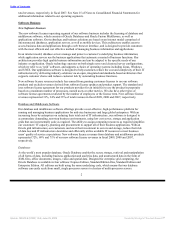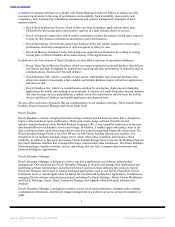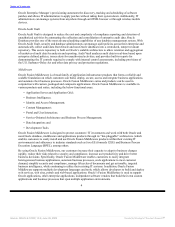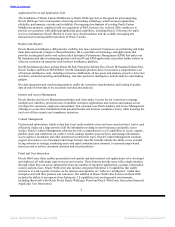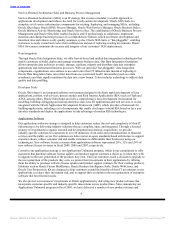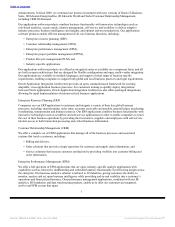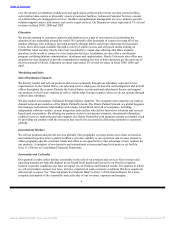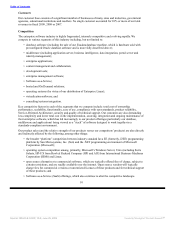Oracle 2008 Annual Report Download - page 7
Download and view the complete annual report
Please find page 7 of the 2008 Oracle annual report below. You can navigate through the pages in the report by either clicking on the pages listed below, or by using the keyword search tool below to find specific information within the annual report.
Table of Contents
total revenues, respectively, in fiscal 2007. See Note 15 of Notes to Consolidated Financial Statements for
additional information related to our operating segments.
Software Business
New Software Licenses
The new software licenses operating segment of our software business includes the licensing of database and
middleware software, which consists of Oracle Databases and Oracle Fusion Middleware, as well as
applications software. Our technology and business solutions are based on an internet model comprised of
interconnected databases, application servers, as well as mobile devices. This architecture enables users to
access business data and applications through a web browser interface, and is designed to provide customers
with the most efficient and cost effective method of managing business information and applications.
In an internet model, database servers manage and protect a customer’s underlying business information,
while application servers run the business applications that automate a myriad of business functions. Our
architecture provides high quality business information and can be adapted to the specific needs of any
industry or application. Oracle technology operates on both single server and clustered server configurations,
which we refer to as “grid” software, and supports a choice of operating systems including Linux, Windows
and UNIX. Our applications software is designed to help customers reduce the cost and complexity of their IT
infrastructures by delivering industry solutions via an open, integrated and standards-based architecture that
supports customer choice and reduces customer risk by automating business functions.
New software license revenues include fees earned from granting customers licenses to use our software
products and exclude revenues derived from software license updates and product support. The standard end
user software license agreement for our products provides for an initial fee to use the product in perpetuity
based on a maximum number of processors, named users or other metrics. We also have other types of
software license agreements restricted by the number of employees or the license term. New software license
revenues represented 31%, 34% and 33% of total revenues in fiscal 2009, 2008 and 2007, respectively.
Database and Middleware Software
Our database and middleware software offerings provide a cost-effective, high-performance platform for
running and managing business applications for mid-size businesses and large global enterprises. With an
increasing focus by enterprises on reducing their total cost of IT infrastructure, our software is designed to
accommodate demanding, non-stop business environments, using low cost server, storage and application
grids that can incrementally scale as required. The ability to assign computing resources as required simplifies
our customers’ IT capacity, planning and procurement to support all of their business applications. With an
Oracle grid infrastructure, our customers can lower their investment in servers and storage, reduce their risk
of data loss and IT infrastructure downtime and efficiently utilize available IT resources to meet business
users’ quality of service expectations. New software license revenues from database and middleware products
represented 72%, 68% and 71% of our new software license revenues in fiscal 2009, 2008 and 2007,
respectively.
Databases
As the world’s most popular database, Oracle Database enables the secure storage, retrieval and manipulation
of all forms of data, including business application and analytics data, and unstructured data in the form of
XML files, office documents, images, video and spatial data. Designed for enterprise grid computing, the
Oracle Database is available in four editions: Express Edition, Standard Edition One, Standard Edition and
Enterprise Edition. All editions are built using the same underlying code, which means that our database
software can easily scale from small, single processor servers to clusters of multi-processor servers.
2
Source: ORACLE CORP, 10-K, June 29, 2009 Powered by Morningstar® Document Research℠

